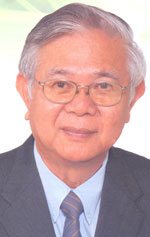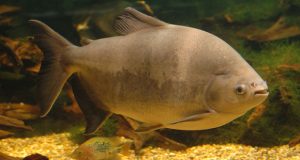CHAIRMAN of the National Aquaculture Association of Guyana, Dr. Leslie Chin said efforts are being stepped up to enable the aquaculture industry to realise its full potential.Aquaculture about a decade ago was touted as a new emerging industry, enjoying the full support of the Government with funding from the United States Agency for International Development (USAID).
But poor management and internal wrangling prevented the industry from taking off, but it has not fizzled out. Currently, there are about 12 significant players in the industry who combined operate an area of about 3,000 hectares.

Dr. Chin said with better management and support, the industry can regain momentum and become a force to be reckoned with.
He said focus will be placed on rearing tambaqui, also known in Guyana as fresh water pacu, which is accepted in European markets and less attention will be given to tilapia, as the market for this fish is very competitive.
Guyana is blessed with an abundance of land, water and an ideal climate for aquaculture, and according to Dr. Chin, if rearing of these two species is successful, attention will be expanded to include shrimp and crayfish.
FAST GROWING SUB-SECTOR
Today, aquaculture is the fastest growing sub-sector in agriculture, and aside from tourism, it is the second fastest growing sector globally.
More than 50 per cent of all fish consumed worldwide come from artificial ponds on land and marine cages, compared to some 7 per cent 45 years ago.
According to Dr. Chin, some Food and Agriculture Organisation (FAO) experts have unofficially estimated that in the next 50 years, some 99 per cent of all fish consumed will come from aquaculture.
But attention to ensure further growth in the industry would not be a ‘walk in the park’. Years ago when the industry was fervently promoted, it was receiving funding from USAID.
That organisation is no longer funding the project, and has since centralised its operation in the Eastern Caribbean, moving from Georgetown to Bridgetown, Barbados.
But funding, he said has not dried up, pointing out that when the USAID funding came to an end, UK AID came on board, and is probably still on board with some remaining in the industry.
It was related that the funding was being administered by Carana Corporation, a US consultancy firm active in the promotion of aquaculture, birding and fishing tourism, drip irrigation and shade house technology.
Some of those still in the industry, Dr. Chin told the Guyana Chronicle, are producing for export, pointing out that at the time the industry was vigorous and strong emphasis was placed on sustainability.
But good practices were not heeded, contributing to a lack of sustained growth in the sub-sector.
RICE-FISH CULTURE
The rice-fish culture (the rearing of fish in rice fields) was also actively promoted but flopped, due to poor attention by farmers. The practice was intended to serve a value-added for small scale farmers to supplement their income.
Dr. Chin, who is currently Chairman of Sterling Products Limited, said in theory, the idea is good, and the returns are there, but it boils down to commitment from farmers to make it work.
“It requires attention,” he said, pointing out that a rice farmer plows his field, throws the seeds and waits after three months for harvesting, but if he is involved in the rice-fish farming, it will be mandatory that he attends his field every day.
He said for the practice to gain traction, it would probably require the involvement of many farmers at the community level.
This, he said, would perhaps create a culture which can grow, develop and become ingrained in farmers, much in the same way as how rice cultivation practices have been embedded in rice farmers.
Dr. Chin, a seasoned private and public sector manager, also said that the New Guyana Marketing Corporation and the National Agriculture Research and Extension Institute (NAREI) can play a helpful role in this process.
He said generally speaking, it will be helpful if these two organisations study the cost structure of the industry, pointing out that such an undertaking will enable them to know where to intervene and offer critical support.
Much like rice, he said, critical support has to be given in research, extension and funding from the banks.
The banks, Dr. Chin added, will be least inclined to fund an aquaculture operation here because there are not many outstanding aquaculture businesses.
But, he said, this can change with the Government assuming a role as an active facilitator in promoting the industry.
Criticism
On this note, he said he admires the business models instituted by the National Industrial and Commercial Investments Limited (NICIL) under its Executive Director Winston Brassington.
Brassington, he pointed out, has developed models of Private Public Partnership, where Government has taken the lead in major projects before handing them over to private operators. Two such projects are the Berbice River Bridge and the Marriott International Hotel.

However, Brassington and the Government have been criticised for their efforts in this regard.
But Dr. Chin said while the models are not perfect, they can be replicated for similar operations in aquaculture.
He emphasised that there must be genuine dialogue, pointing out that many local entrepreneurs have the drive and interest to get into the business, but they would want to see a demonstration effect.
Dr. Chin said with close support given to farmers, along with assistance in helping them to locate markets for their produce, the industry can become the leading economic sector in Guyana.
The Ministry of Agriculture says the fishing industry continues to grow in economic importance in Guyana. This industry employs around 6,500 people in harvesting and a further 6,000 people in processing, with many more benefiting indirectly through fishing related industries such as boat building and gear supply and repair.
CHEAP ANIMAL PROTEIN
It provides a source of relatively cheap animal protein (estimated per capita annual consumption of fish was 54kg in 2003), among the highest per capita consumption of fish and fish products within the Caribbean Region.
Aquaculture production occupies about 3,000 hectares of aquaculture space around the country.
For 2013 alone, the Satayadeo Sawh Aquaculture Station at Mon Repos, East Coast Demerara produced in excess of 93,180, fingerlings compared to 20, 000 in 2008; 85,872 for 2009 and 74, 950 in 2010, 86,689 in 2011 and 81,000 in 2012, which has been distributed to farmers countrywide.
The Ministry of Agriculture, in its National Strategy for Agriculture in the Guyana 2013-2012 plan, said the aquaculture sector will continue to be given prominence in its agriculture diversification drive.
By Tajeram Mohabir




.png)









